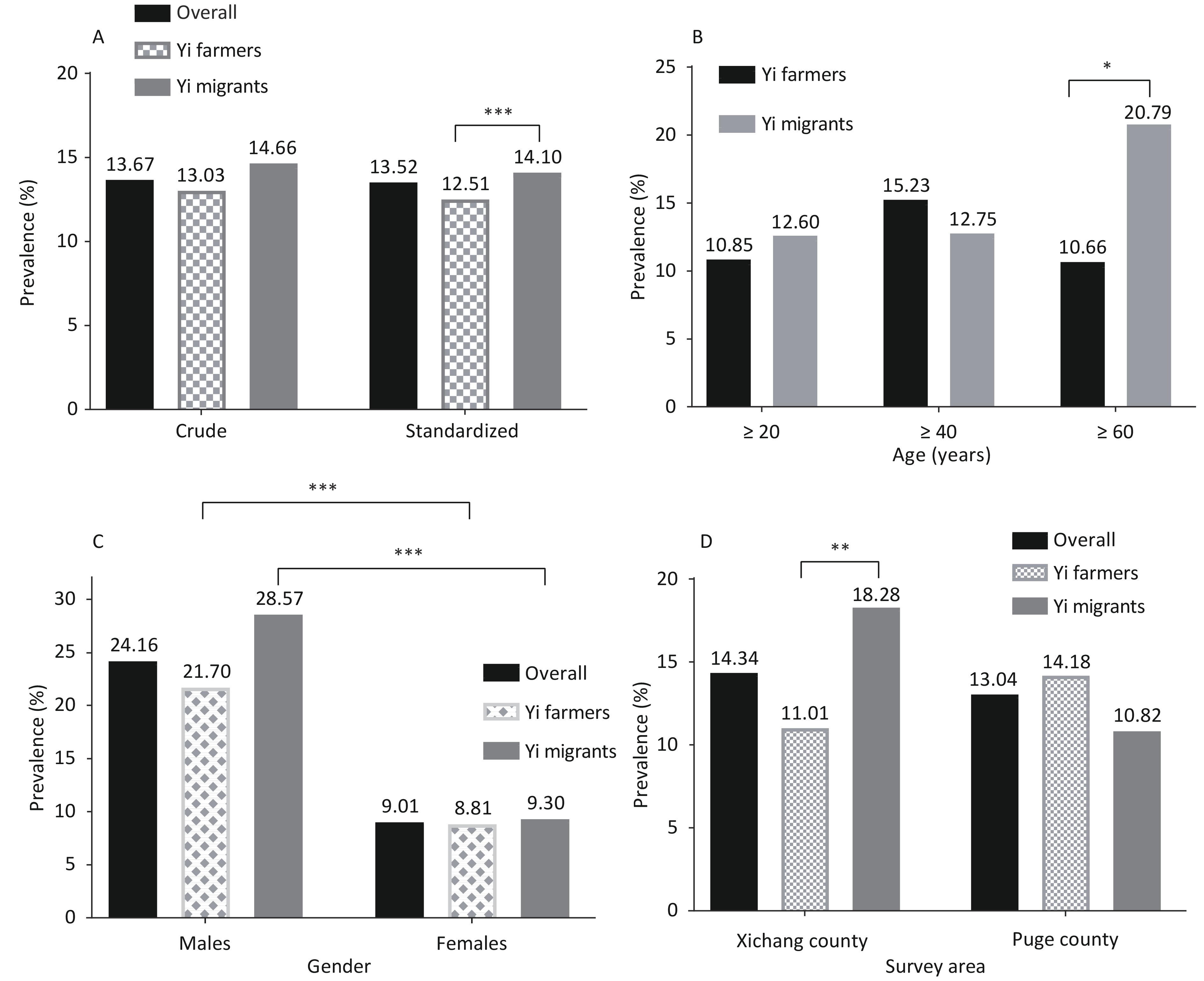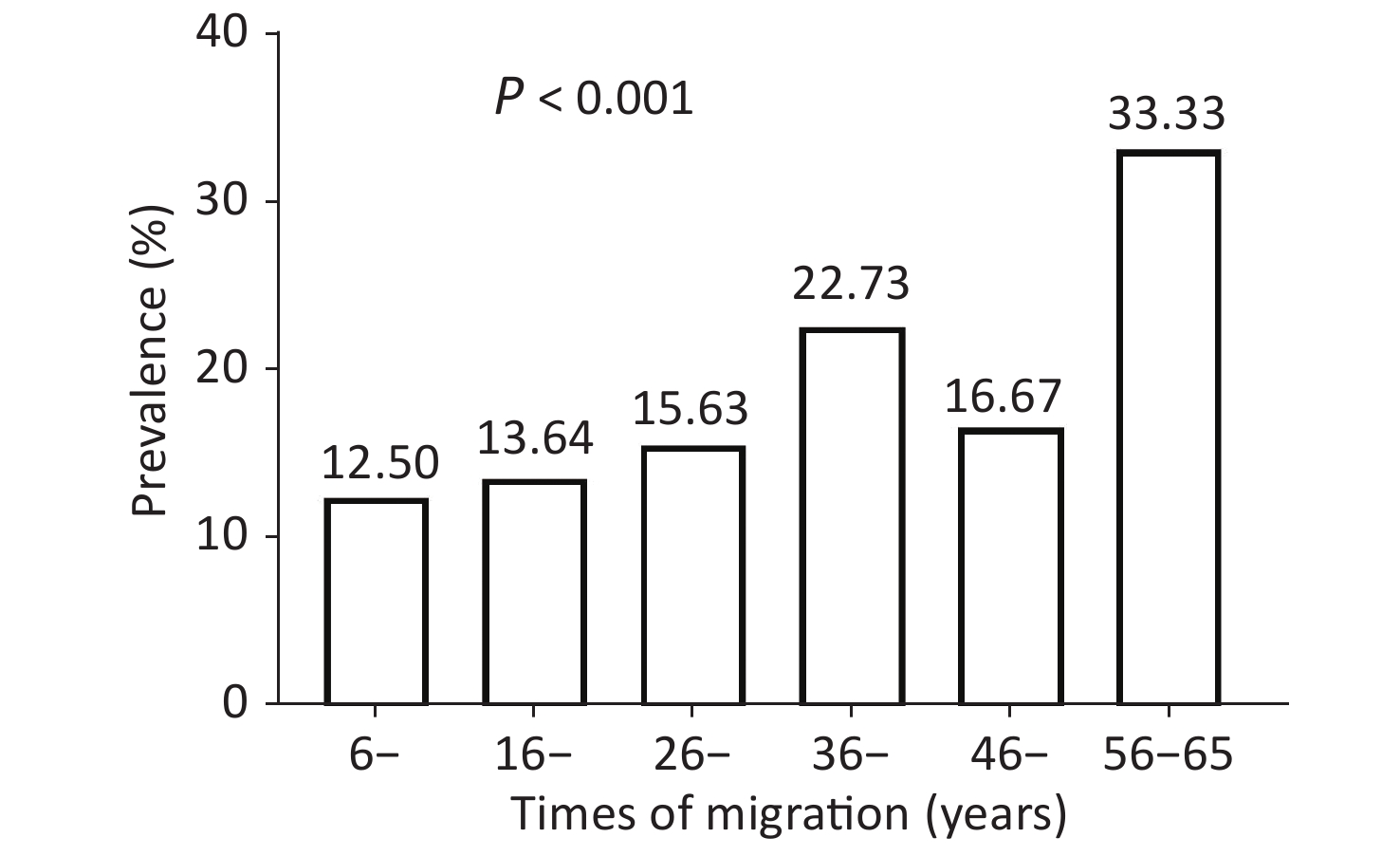-
Hyperuricemia (HUA) is a common metabolic disease caused by increased formation or reduced excretion of uric acid. Although HUA does not cause direct damage to the body, it is closely related to the occurrence of various diseases, including gout, hypertension, diabetes mellitus, metabolic syndrome, and chronic kidney disease. At present, the prevalence of HUA is not as high as that of hypertension, diabetes, etc., but some studies show that the prevalence of HUA is increasing year by year, and its negative impact is large[1], which deserves public attention.
The Chinese population is composed of 56 ethnic groups, among which the Yi minority comprises approximately 0.6% of the total. Initially, most of the Yi population lived in the high mountains or deep valleys, their diets mostly consisted of vegetables (buckwheat, potatoes, corn, rice, wheat, etc.), and their days were occupied by physical labor[2]. As China developed economically and socially, much of the Yi population gradually migrated to cities or towns, which resulted in continuous improvement in their standards of living and subsequent increases in the incidence of several lifestyle-related diseases. Previous studies focused on cardiovascular diseases among Yi farmers and migrants[3], but seldom on the prevalence of HUA among Yi farmers and migrants. Therefore, we conducted a cross-sectional study of HUA and associated factors among Yi farmers and migrants from April to November 2015.
The China National Health Survey (CNHS) was conducted by the Chinese Academy of Medical Sciences to evaluate physiological constants and health conditions in the Chinese. The CNHS used a multistage cluster sampling method. According to the level of urbanization, two locations were chosen randomly chosen for sampling in this cross-sectional study, including a large city (Xichang Center for Disease Control in Xichang city) and a county seat (Puge Center for Disease Control in Puge County). Yi farmers referred to Yi residents who had engaged in agricultural work in rural areas since birth; Yi migrants referred to Yi residents who were born in rural areas and are now living or working in cities and towns.
The inclusion criteria were 1) age 20 years or older; 2) Yi persons whose parents were both Yi minority; 3) for permanent residents, occupancy of current address for longer than 6 months; 4) cognitive awareness and effective language communication; 5) for migrants, occupancy of current residence for more than 5 years. The exclusion criteria were 1) participants with hypertension, hyperlipidemia, diabetes, gout, cancer, kidney diseases, and blood system diseases; 2) participants who were taking diuretics, immunosuppressive drugs, anti-tuberculosis drugs, vitamins, and steroids; 3) psychiatric patients, pregnant women, and active duty soldiers.
A total of 2,147 participants were eligible for our study; 1,838 participants completed the questionnaire, for a response rate of 85.6%. After exclusion of individuals with an invalid questionnaire and those lacking laboratory results, data for 1,838 participants were included in the final analysis. The sample size of Yi farmers and migrants was approximately 1,109 and 729, respectively (Supplementary Figure S1, available in www.besjournal.com).
A questionnaire about demographic information and health history was administered during a comprehensive interview by well-trained interviewers who were proficient in the Yi dialogs. The questionnaire included information about gender, age, ethnicity, educational level, personal income, intensity of physical activity, smoking and drinking, personal and family history of hypertension, time of migration, place of birth (rural or urban), female reproductive history, etc. An assessment of height, weight, blood pressure, and fasting plasma glucose (FPG) was included in routine physical examinations. Height was measured to the nearest 0.1 cm using a fixed stadiometer and in the standing position by bioelectrical impedance analysis with a commercially available body composition analyzer (BC-420, TANITA, Japan) with participants in lightweight clothes. We merged occupational and leisure-time physical activity into an activity level and regrouped it into three levels: low, moderate, and high. Blood pressure was measured three times with an Omron electronic sphygmomanometer. The final output of the instrument was the mean of three blood pressure measurements. The means of both systolic blood pressure (SBP) and diastolic blood pressure (DBP) were given for this part. After 8 hours of fasting, 5 mL of blood was extracted, and blood samples were stored in a –20 °C freezer. The samples were then transported to the General Hospital of the Chinese Peoples’ Liberation Army for processing and analysis. The indexes of FPG, Cholesterol (CHO), triglycerides (TG), low-density lipoprotein (LDL), high-density lipoprotein (HDL), C-reactive protein (CRP), and serum uric acid (SUA) were detected in fasting blood samples. Body mass index (BMI) was calculated using the formula weight (kg)/height (m2).
This study was approved by the local ethics committee, and all participants provided written informed consent before completing this study.
Hypertension was defined as SBP equal to or greater than 140 mmHg and/or DBP equal to or more than 90 mmHg, or subjects were diagnosed with hypertension by dimethyl hospital.
HUA in men was defined as SUA > 420 μmol/L, while HUA in women was defined as SUA > 360 μmol/L [4].
Underweight was defined as BMI < 18.5 kg/m 2, normal weight was defined as 18.5 kg/m2 ≤ BMI < 24 kg/m 2, overweight was defined as 24 kg/m2 ≤ BMI < 28 kg/m 2, obesity was defined as BMI ≥ 28 kg/m2[5].
All data were analyzed with Statistical Package for the Social Sciences version 19.0 software. Quantitative data was expressed as means with standard deviations, and qualitative data were expressed as n (%). The age-standardized prevalence was based on the Sixth National Population Census of the People’s Republic of China. The Chi-square test and Mann-Whitney test were used to compare the demographic differences between Yi farmers and migrants. The differences in HUA distributions between Yi farmers and migrants among different age, gender, and area groups were tested with a Chi-square test. The Cochran-Armitage trend test was used to analyze the significance of an increase or decrease in prevalence across stratifications. The risk factors for HUA were identified through multivariate logistic regression analysis, with adjusted odds ratios (OR) and 95% confidence intervals (CIs) presented together. For statistical analysis, all statistical tests were 2-sided, and differences were considered significant at P < 0.05.
Yi farmers and migrants differed in many demographic aspects in our study. Yi migrants had higher levels of education, age, BMI, DBP, and TG but a lower level of HDL, be they male or female (all P < 0.05) ( Supplementary Table S1A, available in www.besjournal.com).
Variables Men (n = 562) Women (n = 1,276) Yi farmers
(n = 360)Yi migrants
(n = 202)P value Yi farmers
(n = 749)Yi migrants
(n = 527)P value Marital Status, n (%) 0.846 < 0.001 Single 6 (1.7) 5 (2.5) − 20 (3.8) Married 341 (94.7) 118 (93.0) 712 (95.1) 443 (84.1) Divorced 1 (0.3) 1 (0.5) 5 (0.7) 16 (3.0) Widowed 12 (3.3) 8 (4.0) 32 (4.2) 48 (9.1) Educational Status, n (%) < 0.001 < 0.001 Illiteracy 152 (42.2) 12 (5.9) 656 (87.6) 236 (44.8) Primary 136 (37.8) 26 (12.8) 81 (10.8) 100 (19.0) Junior 59 (16.4) 60 (29.6) 11 (1.5) 85 (16.1) Senior 12 (3.3) 55 (27.1) − 49 (9.3) Undergraduate 1 (0.3) 49 (24.1) 1 (0.1) 55 (10.4) Postgraduate and above − 1 (0.5) − 2 (0.4) Smoke, n (%) 0.001 0.719 Never 44 (12.3) 40 (19.7) 709 (94.7) 495 (93.9) Evera 16 (4.4) 23 (11.3) 7 (0.9) 4 (0.8) Smokingb 300 (83.3) 140 (69.0) 33 (4.4) 28 (5.3) Alcohol drinking, n (%) 0.307 < 0.001 Never 43 (11.9) 19 (9.5) 667 (89.4) 396 (75.1) Everc 64 (17.8) 28 (13.9) 8 (1.1) 14 (2.7) Drinkingd 253 (70.3) 154 (76.6) 71 (9.5) 117 (22.2) Family history of hypertension 10 (2.7) 13 (6.4) < 0.001 20 (2.7) 44 (8.3) < 0.001 Family history of diabetes 6 (1.7) 6 (3.0) < 0.001 6 (0.8) 21 (4.0) < 0.001 Family history of cancer 3 (0.8) 6 (3.0) < 0.001 1 (0.1) 13 (2.5) < 0.001 Activities, n (%) < 0.001 < 0.001 Light 30 (8.2) 160 (78.8) 47 (6.3) 384 (72.9) Medium 12 (3.3) 26 (12.8) 26 (3.5) 100 (19.0) Heavy 322 (88.5) 17 (8.4) 675 (90.2) 43 (8.1) Exercise, n (%) < 0.001 < 0.001 5–7 days/week 7 (1.9) 84 (41.4) 3 (0.4) 130 (24.7) 3–4 days/week 7 (1.9) 22 (10.8) − 79 (15.0) 1–2 days/week 5 (1.4) 17 (8.4) 6 (0.8) 58 (11.0) ≤ 3 days/month 4 (1.1) 13 (6.4) 2 (0.3) 22 (4.2) Never 337 (93.7) 67 (33.0) 735 (98.5) 237 (45.1) Note. a‘ever’ refers to smoking in the past but now not. b‘smoking’ refers to smoking now. c‘ever’ refers to drinking once but not drinking for at least half a year from the time of the investigation. d‘drinking’ refers to drinking now. Table S1A. Basic characteristics of the Yi farmers and migrants, Sichuan, China, 2015 — qualitative data
The age-adjusted overall prevalence rate of HUA was 13.52% (95% CI 12.10%–15.24%), in accordance with the worldwide prevalence, reported to range from 2.6% to 36% in different populations, which was lower than the 21% prevalence of HUA reported in the Yi people in the previous study[6] and was lower than the 21.46% reported in Tibetans and 15.59% in Han people in Sichuan Province[7]. This indicates that there may be a racial difference in the prevalence of HUA. The study also found that the prevalence of HUA in Yi migrants (14.10%) was higher than that of Yi farmers (12.51%) (Figure 1A), which may be related to the decrease in physical activity intensity in the absence of farm work and the increase in the drinking rate in females after migration to the city (Supplementary Table S1B, available in www.besjournal.com).
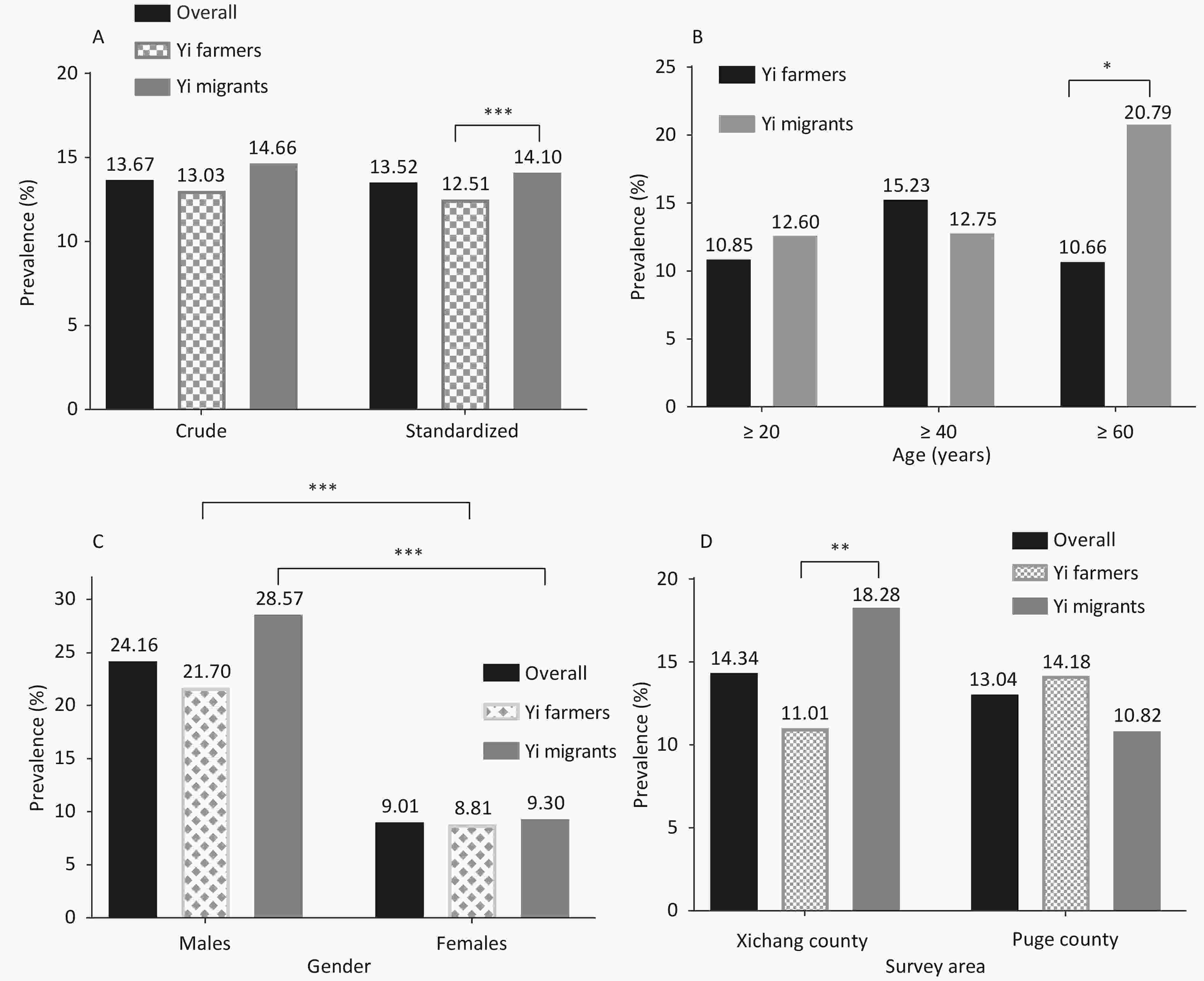
Figure 1. The prevalence of HUA in different age, gender and area groups in the Yi farmers and migrants in southwestern China, 2015. *P
< 0.05, **P < 0.01, ***P < 0.001. Variables Men (n = 562) Women (n = 1,276) Yi farmers (n = 360) Yi migrants (n = 202) P value Yi farmers (n = 749) Yi migrants (n = 527) P value Age (years) 45.56 ± 12.68 49.78 ± 14.28 < 0.001 42.76 ± 10.72 44.60 ± 13.86 < 0.001 BMI (kg/m2) 21.68 ± 3.31 24.14 ± 3.82 < 0.001 22.10 ± 3.34 24.09 ± 3.74 < 0.001 DBP (mmHg) 73.91 ± 11.12 76.48 ± 9.45 0.006 69.34 ± 9.43 72.72 ± 9.98 < 0.001 SBP (mmHg) 122.09 ± 16.37 123.39 ± 14.89 0.350 113.74 ± 13.47 117.12 ± 16.54 < 0.001 TG (mmol/L) 1.38 ± 0.78 1.80 ± 0.96 < 0.001 1.22 ± 0.68 1.56 ± 0.92 < 0.001 HDL (mmol/L) 1.22 ± 0.33 1.08 ± 0.27 < 0.001 1.26 ± 0.28 1.22 ± 0.29 0.033 LDL (mmol/L) 3.19 ± 0.94 3.21 ± 0.88 0.786 2.93 ± 0.77 3.10 ± 0.89 < 0.001 CHO (mmol/L) 5.13 ± 1.09 5.10 ± 0.97 0.742 4.80 ± 0.93 5.01 ± 1.03 < 0.001 SUA (μmol/L) 367.01 ± 74.31 377.76 ± 74.44 0.099 276.09 ± 62.79 280.87 ± 59.26 0.171 FPG (mmol/L) 5.53 ± 1.77 5.53 ± 1.41 0.963 5.23 ± 1.07 5.28 ± 0.96 0.350 Table S1B. Basic characteristics of the Yi farmers and migrants, Sichuan, China, 2015 — quantitative data
Many previous studies have shown that aging is one of the important factors in the prevalence of HUA. Our study also found that the risk of HUA increased with age in Yi migrants in general. Especially, the prevalence of HUA in Yi migrants was clearly higher than that of Yi farmers in the ≥ 60 age group (20.79% vs. 10.66%, P < 0.05) ( Figure 1B). This may be due to the aging kidney, in which the ability to excrete uric acid decreases, causing uric acid to accumulate in the body, and the older Yi migrants had a longer period in which to affected by the environment after migration.
There was no difference in the prevalence of HUA between Yi farmers and migrants, be they male or female (all P > 0.05) ( Figure 1C).
Yi migrants had a higher prevalence of HUA than Yi farmers in Xichang county (18.28% vs. 11.01%, P < 0.01), while there was no obvious difference in Puge county (10.82% vs. 14.18%, P > 0.05) ( Figure 1D). These gaps may be due to the fact that the economy of Xichang county is more economically developed than that of Puge county, and the average duration of migration in Xichang county is also higher than that of Puge county, which make the difference between the Yi farmers and migrants more significant. These results further illustrate that environmental factors have a high impact on HUA.
The shortest duration of migration was 6 years, the longest duration of migration was 65 years, and the average duration of migration was 20.67 ± 12.31 years. The prevalence of HUA in Yi migrants showed an increasing trend with the duration of migration in general (χ2 = 27.171, P < 0.001) ( Supplementary Figure S2, available in www.besjournal.com).
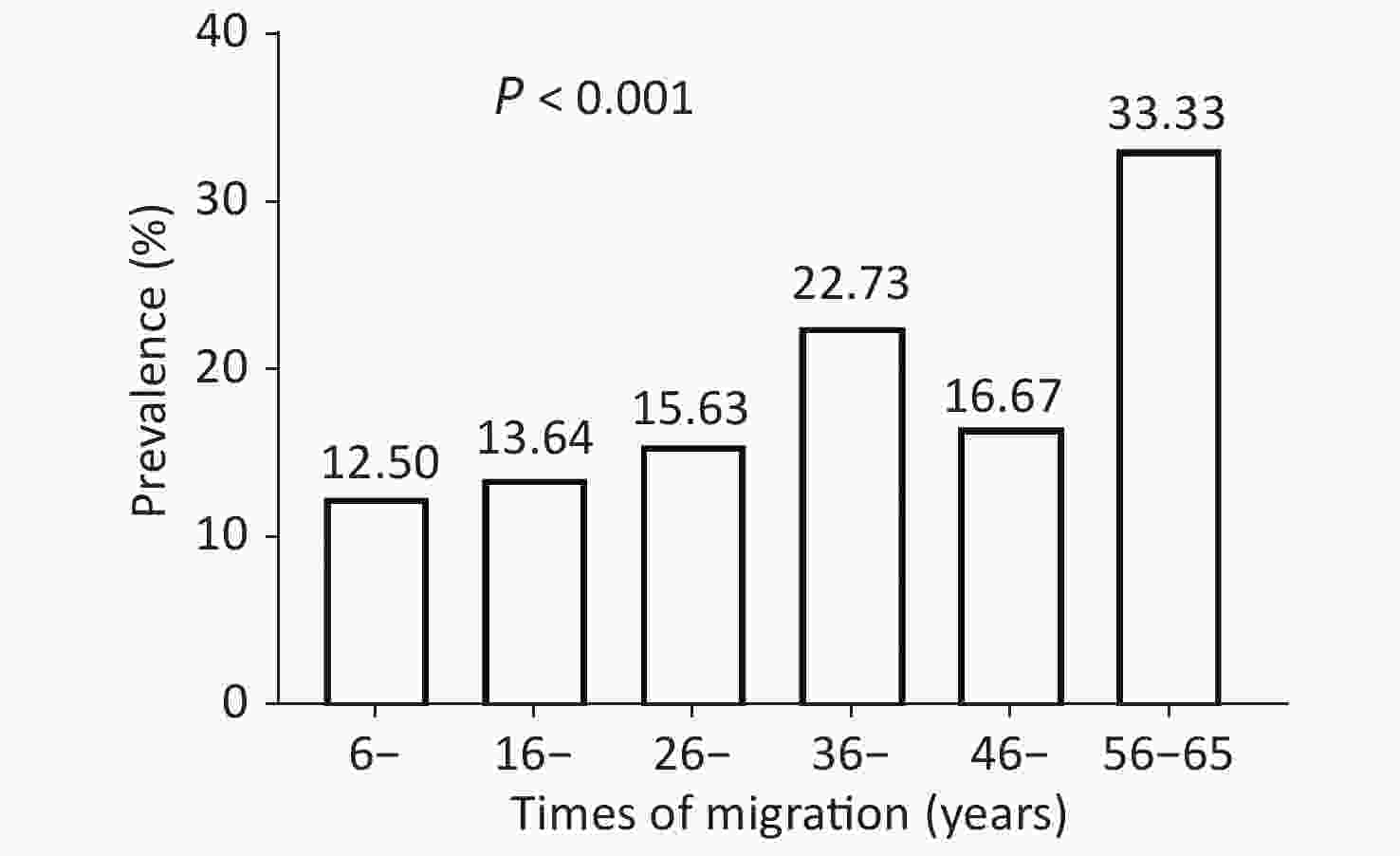
Figure S2. The prevalence of HUA in the Yi migrants with the time of migrantion. (6–, n = 312; 16–, n = 220; 26–, n = 96; 36–, n = 66; 46–, n = 24; 56–65, n = 12)
A multivariate analysis of risk factors showed that gender (compared with male) was a protective factor against HUA (OR= 0.332, 95% CI: 0.142–0.777, P = 0.011) in Yi migrants (Figure 2). Compared with those younger than 30 years old, participants aged 30–49 were less likely to suffer from HUA (OR= 0.354, 95% CI: 0.134–0.939, P = 0.037; OR= 0.161, 95% CI: 0.055–0.467, P = 0.001). Compared with those with a normal weight, participants who were overweight (OR= 2.483, 95% CI: 1.379–4.472, P = 0.002) or obese (OR= 5.304, 95% CI: 2.617–10.751, P < 0.001) had a much higher risk of HUA. Moreover, HUA was also identified in association with TG ( OR= 1.507, 95% CI: 1.179–1.925, P = 0.001); an increased TG concentration may cause fat to accumulate in ectopic tissues such as the kidneys, resulting in compression of the kidneys, which in turn reduces uric acid excretion[8].
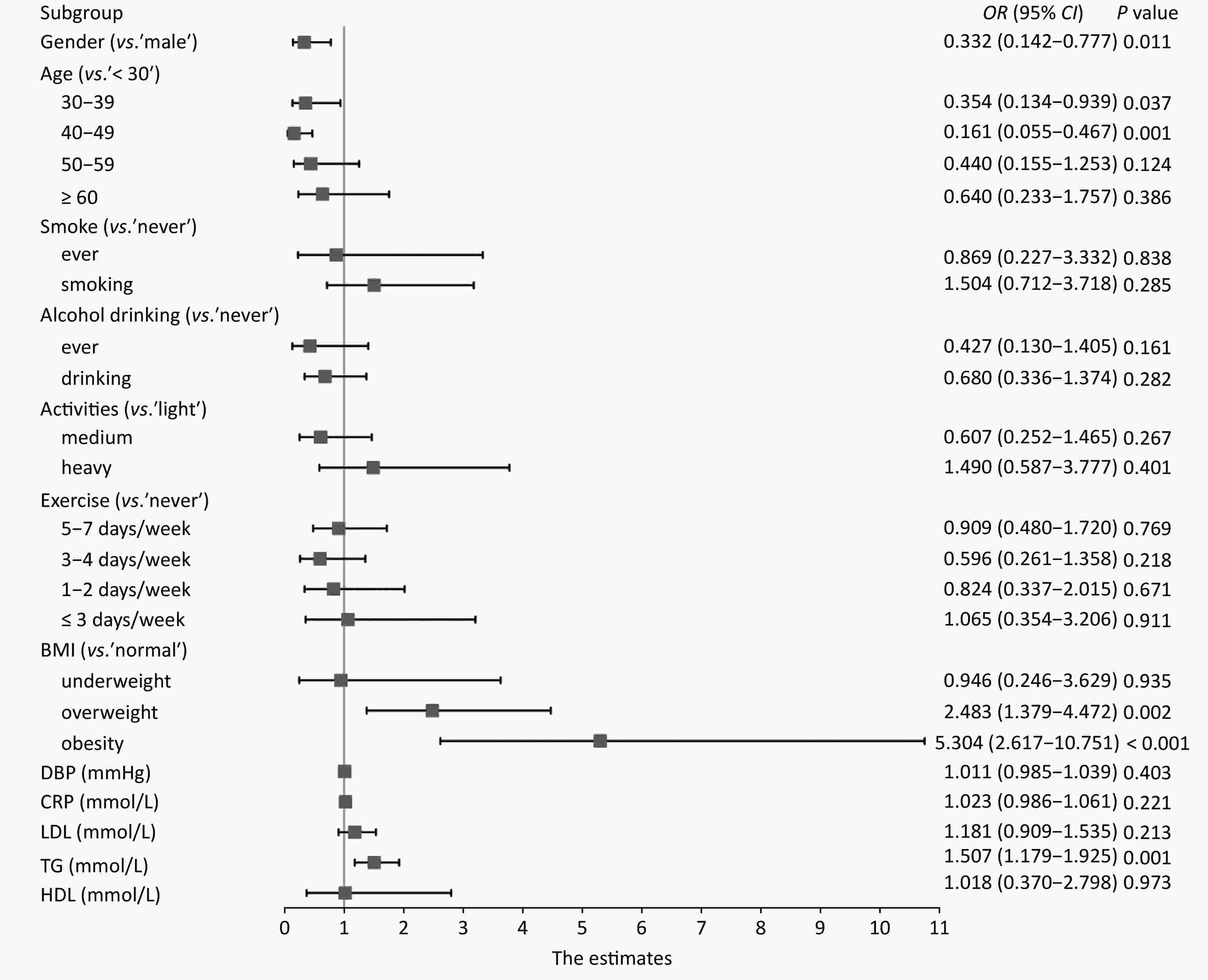
Figure 2. Logistic regression analysis results in Yi migrants. HUA defined as SUA > 420 μmol/L for men and > 360 μmol/L for women.
For Yi farmers (Figure 3), gender (compared with male) was also a protective factor against HUA (OR= 0.436, 95% CI: 0.196–0.973, P = 0.043). Compared with participants aged 20–29 years, those aged 30–39 (OR= 0.437, 95% CI: 0.217–0.879, P = 0.020) had a lower risk of HUA. Compared with those with a normal weight, participants who were obese (OR= 2.902, 95% CI: 1.463–5.759, P = 0.002) had a much higher risk of HUA. HUA was also identified in association with DBP (OR= 1.026, 95% CI: 1.007–1.045, P = 0.007) and family history of diabetes (OR= 8.674, 95% CI: 2.166–34.737, P = 0.002). According to Lopez et al., 15.74% showed alterations in glucose metabolism and 3.70% were diagnosed as DM II among those with a family history of diabetes mellitus, resulting in insulin resistance. Hyperinsulinemia can increase uric acid reabsorption in the proximal tubules leading to HUA.
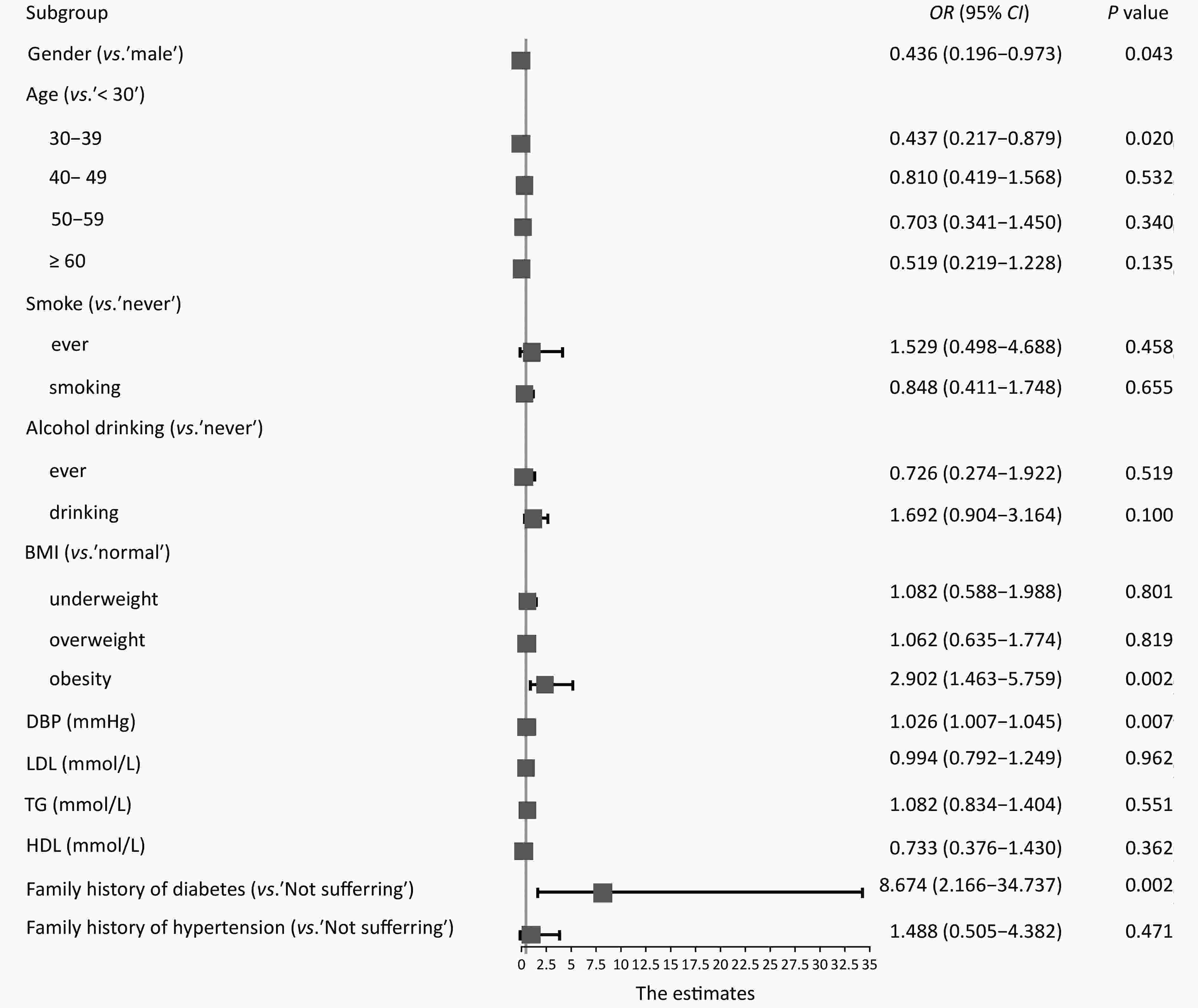
Figure 3. Logistic regression analysis results in Yi farmers. HUA is defined as SUA > 420 μmol/L for men and > 360 μmol/L for women.
The results show that BMI was found to be a significant risk factor whether in Yi farmers or migrants. Notably, obesity is an important risk factor for HUA, with a high body mass index (BMI) correlating strongly with an increased incidence of HUA[9]. According to Simmonds et al.[10]. Overweight or obese people often exhibit endocrine dysfunction, low levels of androgens and adrenocorticotropic hormone or increased ketoacid production, inhibiting uric acid excretion, and this population often consumes more, has accelerated sputum synthesis, and then displays increased uric acid production. Additionally, we found that being female was a protective factor against HUA, whether in Yi farmers or migrants, as has previously been proven in this study.
Our study has several advantages. First, research on the prevalence of HUA among Yi farmers and migrants is still rare. Second, this study included a relatively comprehensive population-based sample from a large city and county site, reasonable response rates, a standardized refraction assessment, and reliable demographic data. However, there are some limitations to this study that require consideration when interpreting our findings. They are that no specific dietary surveys were conducted in the current study, and no dietary factors associated with HUA could be estimated.
In conclusion, our study suggests that Yi migrants have a higher prevalence of HUA than Yi farmers. With multivariate logistic regression, HUA was found to be associated with gender, age, BMI, DBP, and family history of diabetes in Yi farmers, while HUA was associated with gender, age, BMI, and TG in Yi migrants. In order to prevent HUA, at the same time as socio-economic development, health knowledge should be disseminated and healthy lifestyles should be adhered to, especially by Yi migrants.
Prevalence of Hyperuricemia and Associated Factors in the Yi Farmers and Migrants of Southwestern China: A Cross-sectional Study
doi: 10.3967/bes2020.060
- Received Date: 2019-09-25
- Accepted Date: 2020-03-30
| Citation: | WANG Qing Qing, WAN Shao Ping, SHAN Guang Liang, WU Wen Bo, YONG Zheng Ping, PEI Jiao. Prevalence of Hyperuricemia and Associated Factors in the Yi Farmers and Migrants of Southwestern China: A Cross-sectional Study[J]. Biomedical and Environmental Sciences, 2020, 33(6): 448-453. doi: 10.3967/bes2020.060 |


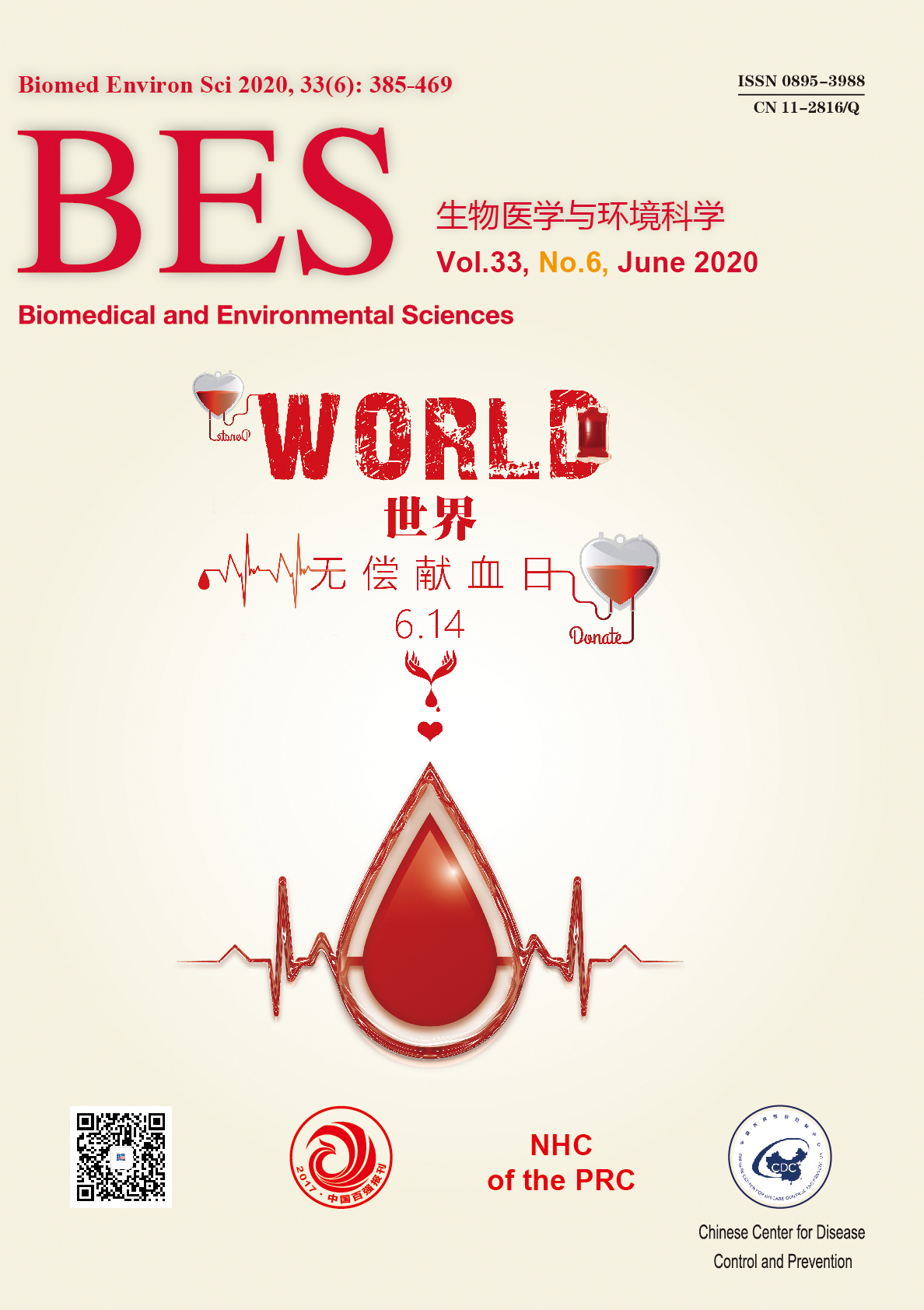






 Quick Links
Quick Links
 DownLoad:
DownLoad:
